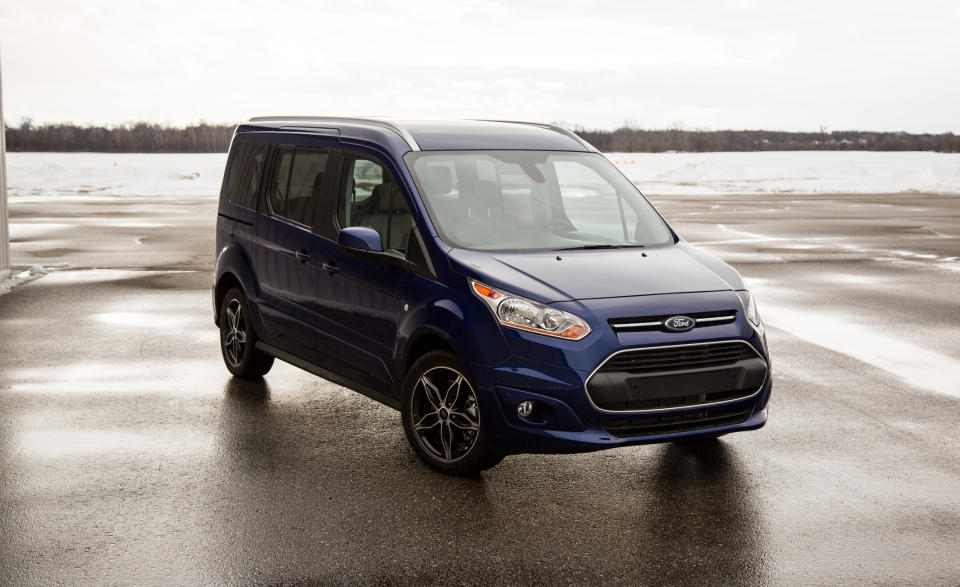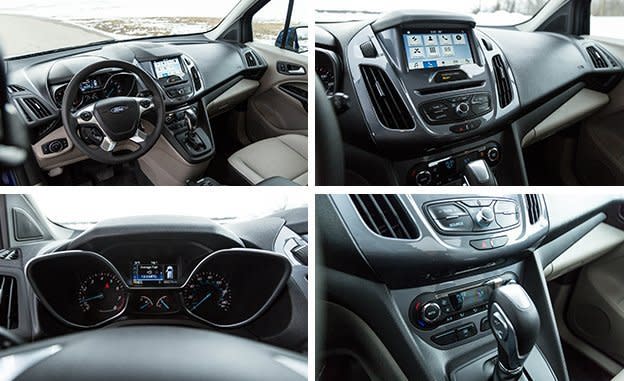2017 Ford Transit Connect Wagon LWB

At Ford, the name Transit is a trunk from which many branches grow. It’s the core calling card for its multisize, multifunction vans. Transit Connect is the designation for the smaller series, of which there also are multiple versions separated into cargo-carrying work vans and passenger-ferrying “wagons.” The formula aims to provide a wide range of possibilities for how the van is used and who uses it, ranging from a contractor to a large family. But because of this van’s dual-purpose nature, our tested top-of-the-range 2017 Ford Transit Connect Titanium sits at an odd place in the market.
Ford is one of few companies offering a three-row passenger version of its compact cargo van. The Nissan NV200 and its Chevrolet City Express twin are strictly work trucks, while the passenger versions of the Ram ProMaster City seat only five. A competitor of similar shape and purpose is the Mercedes-Benz Metris, but that mid-size entry is more than a foot longer with a 5.4-inch-greater wheelbase, not to mention pricier and more powerful.

Ford aims this three-row, long-wheelbase version of the Transit Connect to serve minivan buyers, since the company offers the Flex, the Explorer, and the Expedition as three-row options but has no traditional minivan. And yet, Ford refers to this as the “unminivan.” It has been marketed as a viable option both for businesses and as a no-frills alternative to the Chrysler Pacifica, Toyota Sienna, and Honda Odyssey.
Options Come First, Not Last
The family-friendly version of the Transit Connect comes in either a short-wheelbase (SWB) version with a 104.8-inch span between its axles and a total length of 173.9 inches or a long-wheelbase (LWB) model with a 120.6-inch wheelbase and a total length of 189.7 inches. The SWB offers five-to-seven-person seating, while the LWB model is available in six- or seven-passenger variants. Buyers can choose between rear barn-style swing-open doors or a liftgate on XL and XLT trims; the liftgate is standard on the top-spec Titanium.
Our test example was the long-wheelbase Transit Connect Wagon in Titanium trim with six-person seating. It was equipped with the Premium package, which adds 17-inch black-finished aluminum wheels, a large fixed-glass sunroof, forward and reverse parking sensors, and blind-spot monitoring; the Premium package has a $2345 price tag but brings along a $590 bundling discount. With the $395 Trailer Tow package and $45 daytime running lamps, the total price was a modest $33,515.

The Long and Narrow
Based on Ford’s global C platform that also underpins the Focus and the Escape, the Transit Connect LWB has a vanlike height and length but a more carlike 72.2-inch width, just 0.4 inch wider than a Focus. Combine that with the panoramic visibility afforded by the large windows, easy ingress and egress, a planted chassis, and light, precise steering, and the Transit Connect ends up driving much smaller than it actually is.
The only powertrain is a 2.5-liter inline four-cylinder that makes 169 horsepower and 171 lb-ft of torque. That’s far less than the standard 208-hp turbocharged inline-four in the Metris as well as the V-6s in the Sienna, the Pacifica, and the next-gen Odyssey. That same trio’s eight-, nine-, and 10-speed transmissions make the Transit’s six-speed automatic seem a bit antiquated, too. The Connect chugged from zero to 60 mph in 10.1 seconds in our testing. Although it didn’t feel as pokey in the real world, that’s significantly behind the Benz’s 8.4-second time, while the Pacificas we’ve tested have ranged from 7.3 to 7.6 seconds.
Our recorded 50-to-70-mph time of 7.0 seconds means drivers are going to have to second-guess every attempt to pass other cars in traffic. And that’s not the only reason the Transit Connect feels ill at ease on the highway. It also tended to wander in its lane even in the absence of crosswinds, and it was noisy to boot. Compared with the isolated experience of today’s minivans, the Ford sounded as if it were in a constant struggle to cut through the air, and traversing bumps causes loud, aural thumps to reach occupants’ ears, like you might hear at the “gotcha!” moment in a scary movie.

What About the Kids?
Minivans are accommodation and comfort specialists, with the Odyssey and the Pacifica leading the way in terms of feature sets and driving character. They’ve also become pricey with their entertainment systems, high-class materials, and clever interior features and add-ons. The luxurious Pacifica Limited starts at nearly $44,000, and the Chrysler’s nappa leather almost looks too nice to let kids near. The Transit Connect’s interior, on the other hand, would never be described as luxurious. It’s obvious this is a cargo van with some industrial carpet and a few seats thrown in. There are no screens integrated into the headrests, no USB ports in the rear, no built-in vacuums, no stowaway seats, and no moody ambient lighting. You get two rear rows of stiff, folding captain’s chairs with the rearmost propped up on a platform, stadium-style, and that’s about it. The only high-tech piece found in the Connect is the Sync 3 infotainment system housed in the dashboard.
Rear-seat entertainment in this spacious box comes the old-school way: looking out the giant windows and playing a game of I Spy. This may be a great thing for minimalists who think family time should be spent actually talking to one another, or it could be easily remedied with tablets and phones as alternatives to built-in systems.
The Transit Connect has a distinctive shape and appearance, lower cost, and tight-space maneuverability that is superior to almost every other van. But it simply doesn’t out-minivan traditional minivans, and it’s better suited for taxi, hotel-shuttle, or ride-hailing use. The Connect Wagon is an interesting and useful branch on the Transit trunk, but those looking for a daily family hauler would be better off barking up a different tree.
Specifications >
VEHICLE TYPE: front-engine, front-wheel-drive, 6-passenger, 4-door van
PRICE AS TESTED: $33,515 (base price: $31,320)
ENGINE TYPE: DOHC 16-valve inline-4, aluminum block and head, port fuel injection
Displacement: 2488 cc, 152 cu in
Power: 169 hp @ 6000 rpm
Torque: 171 lb-ft @ 4500 rpm
TRANSMISSION: 6-speed automatic with manual shifting mode
DIMENSIONS:
Wheelbase: 120.6 in
Length: 189.7 in
Width: 72.2 in Height: 72.0 in
Passenger volume: 166 cu ft
Cargo volume: 16.0 cu ft
Curb weight: 4012 lb
C/D TEST RESULTS:
Zero to 60 mph: 10.1 sec
Zero to 100 mph: 43.9 sec
Rolling start, 5–60 mph: 10.3 sec
Top gear, 30–50 mph: 4.8 sec
Top gear, 50–70 mph: 7.0 sec
Standing ¼-mile: 17.6 sec @ 79 mph
Top speed (governor limited, C/D est): 110 mph
Braking, 70–0 mph: 170 ft
Roadholding, 300-ft-dia skidpad*: 0.80 g
FUEL ECONOMY:
EPA combined/city/highway driving: 22/19/27 mpg
C/D observed: 19 mpg
C/D observed 75-mph highway driving: 22 mpg
C/D observed highway range: 340 mi
*stability-control-inhibited

 Yahoo Autos
Yahoo Autos 